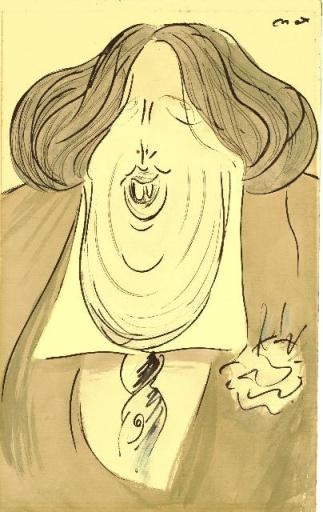February 20-April 26, 2008
Facing the Late Victorians: Portraits of Writers and Artists from the Mark Samuels Lasner Collection
Curated by Margaret D. Stetz
 The Grolier Club will soon present an exhibition that examines noted Victorians through portraits. Facing the Late Victorians: Portraits of Writers and Artists from the Mark Samuels Lasner Collection, curated by Margaret D. Stetz, Mae and Robert Carter Professor of Women's Studies at the University of Delaware, will provide the opportunity for visitors to come face to face with famous British poets, painters, novelists, playwrights and illustrators.
The Grolier Club will soon present an exhibition that examines noted Victorians through portraits. Facing the Late Victorians: Portraits of Writers and Artists from the Mark Samuels Lasner Collection, curated by Margaret D. Stetz, Mae and Robert Carter Professor of Women's Studies at the University of Delaware, will provide the opportunity for visitors to come face to face with famous British poets, painters, novelists, playwrights and illustrators.
This exhibition will take audiences back more than one hundred years to explore a phenomenon that will seem astonishingly modern and familiar. Like the world we know now, Britain at the end of the nineteenth century was a nation filled with images. Whether circulating by means of posters, books, newspapers, magazines, cards, and advertisements, or hanging on the walls of art galleries and of private homes, images were everywhere. As is true today, what people most wanted to see then were images of faces and bodies, especially those of celebrities. A visual industry arose in the late Victorian period to satisfy the demand for portraits in every medium, from photographs to drawings and paintings, and to reproduce these on a mass scale. Pictures of monarchs and stage performers, of course, were in great demand; more surprisingly, so were portraits of what we might call cultural celebrities—that is, writers and artists. Figures such as Oscar Wilde, Robert Louis Stevenson, Aubrey Beardsley, J. M. Whistler, W. B. Yeats, “George Eliot,” and the feminist “New Women” writers were as famous for the way they looked and dressed as for anything they created.
Just as the twenty-first century requires us to decode images, so life in the late Victorian age required portrait literacy. The public learned to read representations of faces for their social meaning, in order to glean information about the class, the economic success, the degree of masculinity or femininity, and the special temperamental qualities of the persons depicted. When looking at pictures of writers and artists, however, what spectators hoped most to find was visual evidence of that elusive thing called “genius.” It was up to the makers of the images, therefore, to provide what audiences wanted and to create visible signs of genius, just as it was up to the subjects of the portraits to compose themselves and their surroundings in a way that would send desirable messages. Writers and artists trafficked in commodities, and they became commodities. Their portraits also provided material for other workers in this industry, such as caricaturists, who knew that the public took just as great a delight in seeing its cultural heroes skewered as idealized. These caricature artists, in turn, became celebrities themselves thanks to the “New Journalism,” which was eager to circulate unflattering images of the same poets and painters it made famous.
Facing the Late Victorians features portraits of dozens of well-known figures such as George Bernard Shaw, J. M. Barrie, H. G. Wells, Arthur Conan Doyle, Thomas Hardy, Henry James, and John Singer Sargent, who dominated the world of the arts, along with pioneering children’s book authors and illustrators, such as E. Nesbit and Kate Greenaway. Many of these are rarely seen images, such as the unpublished sketches of themselves that Rudyard Kipling and Aubrey Beardsley included in letters to friends; the comical drawing of William Morris that the painter Edward Burne-Jones added to his guest-book; or Max Beerbohm’s savage caricature of Oscar Wilde’s head, which seems to decay before our eyes faster than did Dorian Gray’s face. But the show ranges widely to include photographs and drawings of many lesser lights whose work was important in advancing British art and literature—once celebrated writers such as the feminist novelist Olive Schreiner and the Catholic poet Alice Meynell, as well as the artists Walter Sickert and William Rothenstein.
The show draws its eighty items from the Mark Samuels Lasner Collection, which has been assembled over the past thirty years by one of the premier authorities on nineteenth-century book history. That collection of first editions, presentation copies, authors’ correspondence, and works of art and design is on loan to the University of Delaware Library. Margaret D. Stetz, the exhibition’s curator, is the Mae and Robert Carter Professor of Women’s Studies and Professor of Humanities at the University of Delaware.
Facing the Late Victorians is accompanied by a lavishly illustrated book by Margaret D. Stetz, published by the University of Delaware Press. Copies are available on site at the Grolier Club or may be purchased from Associated University Presses, 2010 Eastpark Boulevard, Cranbury, NJ 08512; Phone (609) 655-4770, e-mail [email protected]. web www.aupresses.com ($49.00 ISBN: 978-0-87413-992-1).
Location and times: Facing the Late Victorians: Portraits of Writers and Artists from the Mark Samuels Lasner Collection will be on view at the Grolier Club from. Feb. 21 – April 26, 2008. Hours: Monday-Saturday 10 AM – 5 PM. Open to the public free of charge. For more information call the Grolier Club at (212) 838-6690.